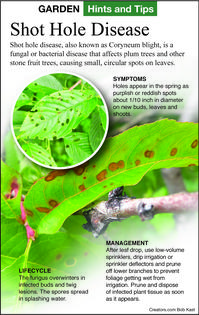The Greener View: Shot Hole Disease and Clematis
Q: We have a cherry plum tree with purple foliage, pink flowers in April and small reddish fruit in July. The leaves look like something is eating at them. There are small holes all over them. I looked for bugs but didn't find any. Can you please let me know what this could be and how to treat it?
A: Plums and other tree fruits with pits get a fungus disease that causes lots of holes in the leaves and ruins the fruit. It is called shot hole disease because the trees look like they have been blasted with a shotgun. You should first look for a fungicide that says it will treat this disease, but you might have to settle for a general-purpose fungicide. Spray the tree after the leaves fall off in the fall because the disease overwinters on the stems and branches. In the spring, spray a week after the flower petals fall off to get better quality fruit.
Q: I have a Clematis that's two or three years old. It started to bloom profusely in early June, but by the end of June, it totally wilted and then turned brown. It has not done this before. What could cause this problem? What treatment should I use on it? Two other Clematis growing nearby, a Henry and a Jackman, are fine.
A: There are a couple of possibilities. Rabbits, other small mammals, insects, slugs or snails may have damaged the stem near the ground. It is possible that the stem was damaged by a lawn mower, a weed eater or just plain being stepped on. All of these potential causes may not have completely damaged the stems at the base of the plant, but the damaged areas may have become infected with a fungal disease, such as verticillium wilt.
So, the first possibility is physical damage alone. The second possibility is a fungal infection that may have happened on its own or with the help of some sort of physical damage.
There is a good chance the Clematis is dead. Some stems may rebound and send out some leaves, but they most likely will not last long if they are on a completely damaged stem. If there is only physical damage and no disease organism, the root system will probably send up some new stems, and the plant will eventually be back to normal.
If there is a fungal disease in the vascular tissue, the plant will wilt, turn brown and die quickly. There is nothing that can be done once the fungus is growing in the plant. Usually, nothing else in the landscape is touched, but sometimes, if there was a common physical problem, such as a flood, then several kinds of plants may be affected by disease organisms.
Wait a couple of weeks to see what the plant does. If it is dead, I would dig out an area larger than the roots and replace it with new soil, and let it sit until next year. At that point, something other than a clematis should be planted there so that the disease doesn't infect the new plant.
========
Email questions to Jeff Rugg at info@greenerview.com. To find out more about Jeff Rugg and read features by other Creators Syndicate writers and cartoonists, visit the Creators Syndicate website at www.creators.com.
Copyright 2025 Jeff Rugg. Distributed By Creators.








Comments